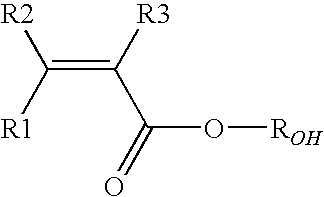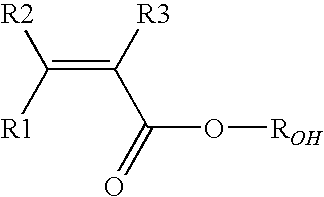Vinylidene fluoride copolymers
a technology of vinylidene fluoride and copolymer, which is applied in the direction of conductive materials, non-conductive materials with dispersed conductive materials, conductive materials, etc., can solve the problems of affecting the thermal stability of the copolymer itself, the final material's mechanical properties are impaired, and the copolymerization of vinylidene fluoride and hydrophilic (meth)acrylic monomers remains a difficult task, etc., to achiev
- Summary
- Abstract
- Description
- Claims
- Application Information
AI Technical Summary
Benefits of technology
Problems solved by technology
Method used
Image
Examples
example 1
[0123]In a 4 liter reactor equipped with an impeller running at a speed of 880 rpm were subsequently introduced the following ingredients:[0124]Demineralized water: 2473 g;[0125]Suspending agent: 0.8 g (Methocel® K100GR from DOW Chemical).
[0126]Reactor was then repeatedly evacuated and purged with nitrogen (1 bar) while maintaining the temperature at 14° C. Then 2 g of acrylic acid (AA) and then 3 g of a solution of the initiator t-amyl perpivalate in isododecane (75%) were introduced into the autoclave and immediately after, 1050 g of VDF monomer were introduced into the reactor. The reactor was then gradually heated until the set-point temperature of 52° C. was attained, which corresponded to a pressure of 120 bar. The pressure was kept constantly equal to 120 bar during the whole polymerization run by feeding an aqueous solution comprising 37 g of AA / I of solution. After 671 minutes the polymerization was stopped by degassing the suspension until reaching atmospheric pressure. A ...
example 2
[0128]Same procedure as detailed in example 1 was followed, but initially introducing in the reactor 1 g of acrylic acid (AA) and 1058 g of VDF monomer and continuously feeding an aqueous solution containing 18.5 g of AA / I of solution. Reaction was stopped after 528 minutes, after having fed a total of 700 ml of AA solution. Recovered amount of dry polymer was found to be 815 g. Composition and DSC properties of so obtained polymer are summarized in Table 1. Data regarding TGA analysis and thermal stability are summarized in Table 2.
example 4
Preparation of Electrode Comprising Polymer of Example 1
[0130]1 g of resin produced as in example 1 was dissolved in 50 g of N-methylpyrrolidone (NMP) under mechanical stirring at room temperature using a Dispermat device equipped with a flat PTFE disc. Under moderate stirring, 1.67 g of SuperP (conductive Carbon Black) and 30.67 g Lithium Cobaltum Oxide (LiCoO2) were added and the slurry was thoroughly mixed to ensure a good homogeneity. All the materials involved in the slurry preparation were previously conditioned either by drying using molecular sieve of 4 Å (for the solvent) or by heating for one night at 100° C. (for the powders). The solid concentration of the composition was 40% weight, polymer (A) representing 3% wt of the total solids components (polymer (A)+active material (carbon black 5% and Li Oxide 92%)). The composition was then degassed under vacuum and spread using a Doctor Blade coating instrument on an Aluminum foil, previously degreased. The coating was finally...
PUM
| Property | Measurement | Unit |
|---|---|---|
| temperature | aaaaa | aaaaa |
| temperature | aaaaa | aaaaa |
| temperature | aaaaa | aaaaa |
Abstract
Description
Claims
Application Information
 Login to View More
Login to View More - R&D
- Intellectual Property
- Life Sciences
- Materials
- Tech Scout
- Unparalleled Data Quality
- Higher Quality Content
- 60% Fewer Hallucinations
Browse by: Latest US Patents, China's latest patents, Technical Efficacy Thesaurus, Application Domain, Technology Topic, Popular Technical Reports.
© 2025 PatSnap. All rights reserved.Legal|Privacy policy|Modern Slavery Act Transparency Statement|Sitemap|About US| Contact US: help@patsnap.com



